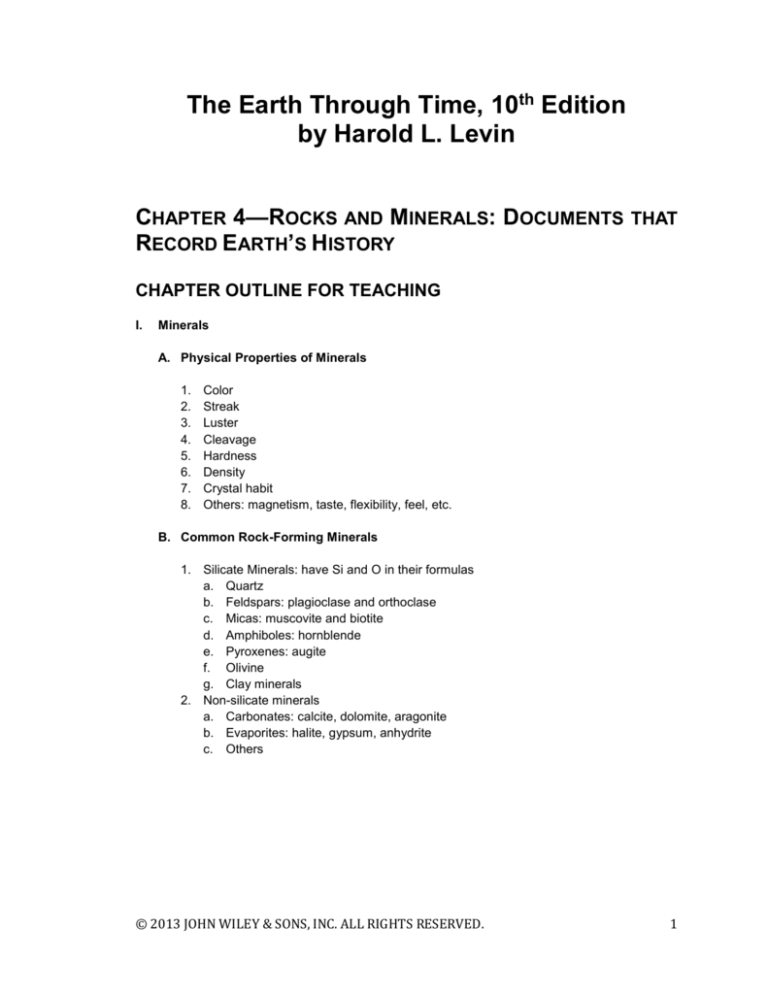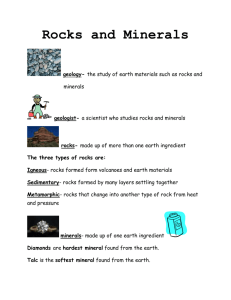
The Earth Through Time, 10th Edition
by Harold L. Levin
CHAPTER 4—ROCKS AND MINERALS: DOCUMENTS THAT
RECORD EARTH’S HISTORY
CHAPTER OUTLINE FOR TEACHING
I.
Minerals
A. Physical Properties of Minerals
1.
2.
3.
4.
5.
6.
7.
8.
Color
Streak
Luster
Cleavage
Hardness
Density
Crystal habit
Others: magnetism, taste, flexibility, feel, etc.
B. Common Rock-Forming Minerals
1. Silicate Minerals: have Si and O in their formulas
a. Quartz
b. Feldspars: plagioclase and orthoclase
c. Micas: muscovite and biotite
d. Amphiboles: hornblende
e. Pyroxenes: augite
f. Olivine
g. Clay minerals
2. Non-silicate minerals
a. Carbonates: calcite, dolomite, aragonite
b. Evaporites: halite, gypsum, anhydrite
c. Others
© 2013 JOHN WILEY & SONS, INC. ALL RIGHTS RESERVED.
1
II. Rocks (Great Rock Families)
A. Igneous Rocks
1. Cooling history of magma or lava (revealed by texture)
a. intrusive (plutons, dikes, sills)
b. extrusive (lava flows, ash falls)
c. two-stage (porphyritic rocks)
2. Mineral composition
a. silica-rich rocks (granite, rhyolite)
b. intermediate rocks (granodiorite, diorite, andesite)
c. silica-poor rocks (gabbro, basalt)
3. Crystallization of magma
a. first-formed minerals have more perfect shapes
b. Bowen’s reaction series helps us understand order of mineral formation
(i) continuous reaction series: feldspar composition changes
(ii) discontinuous reaction series: iron-rich silicate minerals reacts with liquid
4. Volcanism (volcanic activity)
a. basaltic magmas (partial melting of upper mantle)
b. andesitic magmas (fractional crystallization of melting crust and mixing of basaltic
magma and siliceous sediments)
B. Sedimentary Rocks
1. Lithification: compaction and/or cementation
2. Ubiquitous structure: layering (stratification)
3. Derivation by weathering
a. decomposition (chemical)
b. disintegration (physical)
4. Sedimentary textures
a. clastic
b. non-clastic
5. Classification
a. clastic rocks: conglomerate, breccia, sandstone, siltstone, shale
b. non-clastic rocks: carbonates (limestone, dolostone), chemical (chert, rock salt),
biochemical (coal, chalk)
c. other sedimentary rocks: chert, evaporites, coal
C. Metamorphic Rocks
1. Metamorphic processes
a. regional
b. contact
2. Metamorphic index minerals
a. form under specific temperature and pressure conditions
b. range from low grade (chlorite) to high grade (sillimanite)
3. Metamorphic textures and kinds of rocks
a. foliated: slate, phyllite, schist, gneiss
b. non-foliated: marble, quartzite, greenstone, hornfels
© 2013 JOHN WILEY & SONS, INC. ALL RIGHTS RESERVED.
2
4. Classification
a. foliated rocks: slate, phyllite, schist, gneiss
b. non-foliated rocks: marble, quartzite, greenstone, hornfels
5. Metamorphic grades (facies)
a. show historical significance in terms of past metamorphic conditions of
temperature and pressure
b. delineated by index (metamorphic) minerals
Answers to Discussion Questions
1. Minerals are naturally occurring solid, inorganic substances that have a definite chemical
composition or range of compositions as well as distinctive properties that reflect the
composition and regular internal atomic structure. Minerals have regular internal structures
of atoms, unlike amorphous non-crystalline materials like volcanic glass.
2. The eight most abundant chemical elements of the Earth's crust (in order of abundance) are:
oxygen (O); silicon (Si); aluminum (Al); iron (Fe); calcium (Ca); sodium (Na); potassium (K);
and magnesium (Mg).
3. The silicate minerals are the most common minerals forming about 75% by weight of the
Earth's crust. Silicate minerals are important because we live on a silicate world. Silicates
are based on silica, a bonding of one silicon atom and four oxygen atoms (the most common
elements of the crust). Granite is made of quartz and feldspar, the two most common
silicates. Silicate minerals common in sedimentary rocks are quartz, feldspar, mica, and clay.
4. Granite, made of quartz and feldspar, is the rock that best approximates continental crustal
composition. Basalt, made of ferromagnesian silicates and plagioclase feldspar, best
approximates oceanic crustal composition.
5. Partial melting occurs where pressure is slightly relieved and minerals with select melting
points will liquefy and mobilize at the expense of others left behind. In fractional
crystallization, some crystals form in the liquid magma as it cools. These crystals fall out or
are removed thus making the liquid a different composition. The former generally works to
enrich liquids in mafic minerals; the latter to enrich liquids in silicic (lighter) minerals.
6. Grain sizes (crystal sizes) of igneous rocks indicate cooling history: the larger the crystal, the
slower the cooling rate. Mixed crystal sizes indicate two stages of cooling. Magmas that have
high viscosity generally are relatively low in silica content.
7. In order of increasingly finer grain size, clastic sedimentary rocks are called: conglomerate (or
breccia); sandstone; siltstone; and shale (or claystone).
8. Clastic rock grains are most commonly composed of minerals quartz, feldspar, micas, and
clay. Clastic rock cements are most commonly calcite, hematite, and quartz. Carbonate
rocks are composed mainly of calcite and (or) dolomite. Chert is a finely crystalline form of
quartz. Evaporites are composed mainly of halite and (or) gypsum.
© 2013 JOHN WILEY & SONS, INC. ALL RIGHTS RESERVED.
Page 3
9. Chert is a finely crystalline rock that has no cleavage and has hardness near 7. The chert
lends itself to flaking and shaping into a spear point and will keep a sharp edge. Limestone
can also be finely crystalline rock that has no cleavage, but limestone tends to break along
stratification (layering), which can be spaced at small intervals. Limestone is made of calcite,
which is a rather soft mineral (H=3). Therefore chert, which is harder, is preferable for an ax
head.
10. Marble is rather soft and tends to be finely crystalline and without natural planes of weakness
like foliation. Gneiss is much harder due to its silicate mineral content and is strongly foliated,
which introduces natural planes of weakness into the rock. Quartzite tends to be more like
marble in terms of texture, but is made of a rather hard mineral (quartz), which could be
difficult to work with.
11. In order of increasingly common foliation, metamorphic rocks are slate, phyllite, schist, and
gneiss.
12. a
13. a
14. a
15. d
16. d
CHAPTER ACTIVITIES
Student activities for in-depth learning:
1. Select five minerals mentioned in this chapter and do some research on them. Once you have
your list, go to the alphabetical list of mineral species at WebMineral.com:
(http://webmineral.com/Alphabetical_Listing.shtml). Click on the first letter of the mineral name
and find the mineral. Make a list of the main physical properties for your minerals and also make
a note of the chemical formula, the origin of the name of the mineral, and some synonyms.
2. Take a look at the picture gallery of sedimentary rocks at Geology.com
(http://geology.com/rocks/sedimentary-rocks.shtml). Study the photographs of the sedimentary
rocks and read what the page says about them. What are the differences between the three
types of sedimentary rocks on that page? Briefly discuss this and how you would distinguish
between the three types using observations you could make with your unaided eye.
© 2013 JOHN WILEY & SONS, INC. ALL RIGHTS RESERVED.
4









